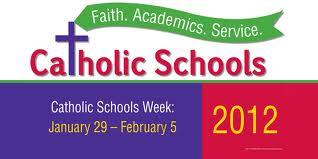
By Wendy Innes.

A sixth-grade math class at St. Raphael S School in Bridgeport, Conn., where Catholic elementary enrollment is rising. Photo by Susan Farley
As the world evolves, determined parents create an atmosphere where providing their children with the best of everything is equivalent to sending them off to school with the coolest backpacks, greatest up to date electronics, anything to help them in their educational ventures. However, parents often neglect one of the most important aspects in their child’s backpack full of expensive goodies, encouragement.
Inspiration is a real-world strategy that helps develop children into adults capable of overcoming adversity and reaching beyond perceived limitations. Encouragement provides children with positive self-esteem, the strength to persevere, and reach their greatest potential, which in turn builds a solid intellectual thought process and positive decision-making ability.
A 2011 study published in the International Journal of Academic Research reveals that in the academic environment, educators that implemented positive encouragement within their classroom created a much less stressful atmosphere. Students, encouraged by their teachers conveyed positive attitudes, better self-esteem, and learning.
By implementing the same positive environment at home, parents help their children realize that each is an amazing individual who is equipped with the ability and drive to do anything. Unfortunately, most adults live in a fast-paced world riddled with constant interruptions, agendas full of important commitments, and long lists of imminent needs, leaving very little time for motivational speeches. However, this motivation is the first stepping-stone to accomplishment, and it is up to the parents to provide the inspiration and aspiration to create this atmosphere for their child. Starting early is the best-case scenario, but starting is the bottom line, no matter the age.
Setting aside time every day for positive interaction such as having conversations that go beyond typical phrases like, “Did you do your homework?” or “Get ready for bed.” Encourage your child to share what they learned in a specific class, praise them for their personal achievements, or be supportive and understanding if they are struggling. Rather than judgment, use encouragement to reinforce their willingness to try again.
A positive attitude and atmosphere creates a better quality of life at home and at school, and remember, regardless of age, it’s never too late to start because all people thrive on recognition. Encouragement is the first step in creating a self-confident and motivated adult who wants to perform to their highest ability.
It is unclear how the allegations of sexual abuse affected Catholic schools in the areas of enrollment and retention of employees, but much like the numerous scandals, the Church is not forthcoming with that information.

St. Theresa School in Coral Gables, Florida. It is one of over 125,000 Catholic grade schools all over the world offering Catholic religious education to both private and public school students.
Hands-down, the anecdotal evidence provided by those who either attended a Catholic school or have children attending is that the education is superior, but there were some interesting explanations as to why people felt that way.
“What Catholic schools excel in is providing the enrolled child and parents with connections, friendships, and networking to a more influential and actively involved group of individuals,” says Lisa Morel Las, Joliet, Ill. Las attended Catholic schools from kindergarten through post-graduate courses, and then worked as a Catholic high school guidance counselor and an admissions director at a Catholic college.
“This is especially helpful for high school students looking for part-time and summer employment, and college students looking for jobs after graduation,” she adds. “Additionally, more students are on the path to successful completion than at public schools, due to parental expectations. Thus, the Catholic school child has more positive influence to graduate and go on for further education.”
This idea of communion with each other is central to the Catholic school as well as the Catholic Church.
Ray Porter, Houston, Texas, who attended both public and Catholic schools, says, “I believe Catholic school not only offers a better education, but more importantly an environment more conducive to learning. In Catholic school, I felt like I was learning, not being prepared for a standardized test.”
A common complaint among parents, especially those with children attending public schools before Catholic school is that they felt their children were doing just enough to get by rather than reaching their full potential.
“I also received more one-on-one attention because of the smaller class sizes. Catholic schools can determine their own curriculum, so I was often working at 1 to 1.5 grade levels higher than my public school counterparts,” Porter continues. “When I went to a public high school, this fact became obvious to me because a lot of the material we covered were things I had learned in 8th and 9th grades.”
Porter says that because families have to apply to and pay for the Catholic schools, they are more invested in their children’s education. “In Catholic schools, they control who comes into the schools, and there tends to be a better overall caliber of student, with families focused on education. In the public high school, I found myself around people who did not care about high school, and had no interest in post secondary schooling. I think this is truly an example of ‘you get what you pay for.’”
Joe Reblando, New York, says, “I believe that Catholic schools do provide a better education than public schools. Having gone to both, I can tell you that I had more discipline and focus at my Catholic school. At Chaminade High School [a Catholic school] in Mineola, N.Y., I was encouraged to excel by my teachers, and driven to succeed because of the competition I felt with my more intelligent peers. Both of these factors were lacking in W.T. Clarke in Westbury, N.Y. the local public school I attended in junior high.”
The encouragement and individual attention of teachers and parents seems to set Catholic schools apart from their public school counterparts. While there is no doubt that teaching is a thankless job that really takes a special kind of person, Catholic schools attract a higher caliber of teacher due to better pay and benefits, which in the public school system is governed by funding from the local, state, and federal governments.
Karen Klemens, Pasadena, Calif., says, “If I were to compare our Catholic school to the public schools in our area, I would say my son is getting a superior education, especially for the money. Our Catholic school provides an arts education, which results in our music and arts teachers remaining employed, plus, my son, who is in kindergarten is learning Spanish from a separate teacher.”
Klemens notes, “Our class size is a bit on the high side, about 24-25 students per class, but the teacher has an assistant and plenty of volunteers. It is my understanding that our public school in Pasadena has about 28 students per class with no assistant to help the teacher. Our school also has a quality after school program, with plenty of paid staff.”
Of the people interviewed, everyone shared the same opinion that Catholic schools were far better than public schools, but often those who most want their children to attend a Catholic school for this superior education cannot afford the high cost of tuition. This often affects Latino communities, which according to a report on the National Hispanic Christian Leadership Conference website, “the Hispanic Churches in American Public Life national survey shows 70 percent of American Latinos are Catholic.” However, they are often too poor to pay the tuition costs.
According to the Second Vatican Council, “First and foremost, the Church offers its educational services to the poor, or those who are deprived of family help and affection, or those who are far from faith…” However, does the high cost of tuition and uniforms reflect the mission of the Church and school in staying true to helping the poor and disaffected?
When asked about the Church’s mission of helping the poor, Klemens said, “As far as schools staying true to their mission, I would say yes. Once a month or so, students, for $1, can come in free dress (out of uniform) and the money that is collected goes toward those in need, most recently, Haiti. They are learning philanthropy from an early age, collecting food for the needy, adopting classes from schools in areas of poorer neighborhoods, etc.”
There are tuition assistance programs through the diocese of each school, which does allow some poorer children to attend, however much of that is dependent upon the generosity of parishioners at the collection plate. So in hard times when the faithful are feeling the economic pinch, the trickle down affect leaves the poor being pinched even harder.
Catholic schools allow non-Catholic students to attend at a higher tuition rate. Parents can contact their local diocese for information about enrolling their child.
The schools provide a solid, competitive education to students and a sense of community for parents, teachers, and students. In an ideal world, isn’t that what a school is supposed to do?
Sources: Grace, Gerald Rupert; Joseph, O’Keefe (2007), “Copyright: Catholic schools facing the Challenges of the 21st century: An overview”, International Handbook of Catholic Education Challenges for School Systems in the 21st Century (The Netherlands: Springer) Volume 2, 2007, DOI: 10.1007/978-1-4020-5776-2: 1–11, ISBN 978-1-4020-5776-2 http://www.richmonddiocese.org/ocs/
http://www.vatican.va/roman_curia/congregations/ccatheduc/documents/rc_con_ccatheduc_doc_20070908_educare-insieme_en.html http://www.nhclc.org/news/latino-religion-us-demographic-shifts-and-trend
Article reprinted with permissionof USAonRace.com
Featured Photo Credit: greatbendpost.com







No Responses to “Catholic Schools As Educational Option”